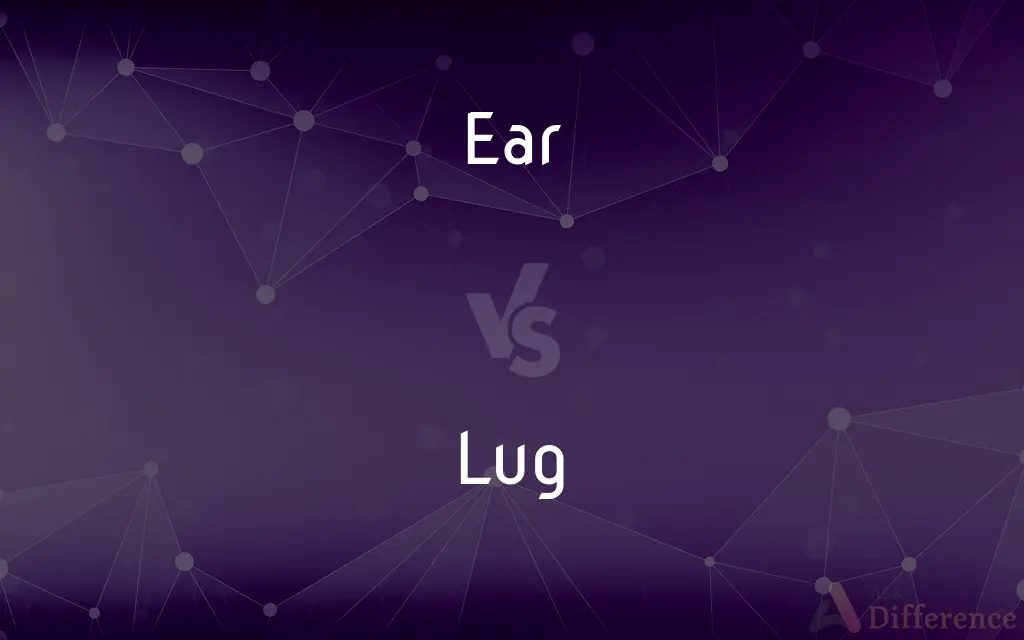Ear vs. Lug — What's the Difference?
By Maham Liaqat & Urooj Arif — Updated on March 22, 2024
Ears facilitate hearing, while lugs are used for carrying or attaching.

Difference Between Ear and Lug
Table of Contents
ADVERTISEMENT
Key Differences
An ear is a part of the body that is essential for hearing and balance. Located on either side of the head, ears allow us to detect sound waves and convert them into signals that the brain can understand. This biological function is critical for communication, safety, and the enjoyment of sounds and music. On the other hand, a lug is a type of handle or projection used for carrying, lifting, or securing something. It can be found on a variety of objects, from suitcases and electrical components to machinery and cooking pots, serving as a point of attachment or for facilitating movement.
While ears are a natural and vital part of human and animal anatomy, enabling the sense of hearing and contributing to balance and spatial orientation, lugs are man-made components designed to aid in the physical handling or mounting of objects. The purpose of lugs is purely functional, often related to the mechanics of carrying, fixing, or connecting items, whereas ears play a complex role in sensory perception and interaction with the environment.
Ears are characterized by their unique anatomical structure, which includes the outer ear, middle ear, and inner ear, each contributing to the process of hearing and balance. Lugs, however, vary widely in shape, size, and material, depending on their specific application, from simple protrusions on containers to sophisticated fittings in technical equipment.
In the context of usage, the term "ear" is universally understood to refer to the organ of hearing, but "lug" can have different meanings based on context, sometimes referring to the act of carrying something heavy with effort. Despite these differences, both terms can imply a function of support—ears support the senses, while lugs support physical handling or attachment.
The care and maintenance of ears involve health and hygiene practices to prevent infections and hearing loss, including regular cleaning and protecting ears from loud noises. For lugs, maintenance might involve ensuring they are securely attached, not damaged, and capable of withstanding the weight or stress they are designed to handle, to ensure the safety and functionality of the object they are a part of.
ADVERTISEMENT
Comparison Chart
Function
Facilitates hearing and balance.
Used for carrying, lifting, or securing objects.
Nature
Biological organ in humans and animals.
Man-made component or feature on objects.
Role
Critical for communication, safety, and enjoyment of sounds.
Functional, aiding in the physical handling or attachment of items.
Structure
Consists of the outer, middle, and inner ear.
Varies in shape, size, and material depending on application.
Maintenance
Involves health and hygiene practices.
May require checks for secure attachment and absence of damage.
Compare with Definitions
Ear
An organ for hearing and balance.
She wore earrings to accentuate her ears.
Lug
A projection used for carrying or lifting.
The suitcase had a sturdy lug for easy transport.
Ear
The part of the body that detects sound.
He whispered softly into her ear.
Lug
Essential for the functionality of many devices and containers.
The machine's lug was bolted on for extra support.
Ear
Involved in the auditory process.
Musicians protect their ears to maintain hearing sharpness.
Lug
A handle or attachment point on an object.
The pot's lugs were designed to distribute weight evenly.
Ear
Essential for spatial orientation and equilibrium.
Inner ear issues can lead to balance problems.
Lug
Used in various applications for convenience in handling.
The battery had lugs for secure connections.
Ear
A critical sense organ located on the head.
The doctor checked his ears during the examination.
Lug
Can refer to the act of carrying something heavy.
He lugged the heavy box up the stairs.
Ear
The ear is the organ that enables hearing and, in mammals, balance. In mammals, the ear is usually described as having three parts—the outer ear, the middle ear and the inner ear.
Lug
A handle or projection used as a hold or support.
Ear
The organ of hearing and balance in humans and other vertebrates, especially the external part of this.
Lug
A lug nut.
Ear
The seed-bearing head or spike of a cereal plant.
Lug
(Nautical) A lugsail.
Ear
The vertebrate organ of hearing, responsible for maintaining equilibrium as well as sensing sound and divided in mammals into the external ear, the middle ear, and the inner ear.
Lug
A projecting part of a larger piece that helps to provide traction, as on a tire or the sole of a boot.
Ear
The part of this organ that is externally visible.
Lug
A copper or brass fitting to which electrical wires can be soldered or otherwise connected.
Ear
An invertebrate organ analogous to the mammalian ear.
Lug
(Slang) A clumsy fool; a blockhead.
Ear
The sense of hearing:a sound that grates on the ear.
Lug
The act of lugging.
Ear
Sharpness or refinement of hearing:a singer with a good ear for harmony.
Lug
Something lugged.
Ear
The ability to play a passage of music solely from hearing it:plays the piano by ear.
Lug
A box for shipping fruit or vegetables.
Ear
Responsiveness to the sounds or forms of spoken language:a writer with a good ear for dialogue; has an ear for foreign languages.
Lug
The ancient Celtic god of artisanship and warriors. He was said to be the father of Cuchulain.
Ear
Sympathetic or favorable attention:"[The president] wavers between the two positions, depending on who last had his ear"(Joseph C. Harsch).
Lug
To drag or haul (an object) laboriously.
Ear
A flexible tuft of feathers located above the eyes of certain birds, such as owls, that functions in visual communication but not in hearing.Also called ear tuft.
Lug
To pull or drag with short jerks.
Ear
A projecting handle, as on a vase or pitcher.
Lug
To cause (an engine, for example) to run poorly or hesitate
If you drive too slowly in third gear, you'll lug the engine.
Ear
A small box in the upper corner of the page in a newspaper or periodical that contains a printed notice, such as promotional material or weather information.
Lug
To pull something with difficulty; tug.
Ear
Ears(Informal)Headphones.
Lug
To move along by jerks or as if under a heavy burden.
Ear
The seed-bearing spike of a cereal plant, such as corn.
Lug
To run poorly or hesitate because of strain. Used of an engine
The motor lugs on hills.
Ear
To form or grow ears.
Lug
The act of hauling or dragging.
A hard lug
Ear
(countable) The organ of hearing, consisting of the pinna, auditory canal, eardrum, malleus, incus, stapes and cochlea.
Lug
That which is hauled or dragged.
The pack is a heavy lug.
Ear
(countable) The external part of the organ of hearing, the auricle.
Lug
Anything that moves slowly.
Ear
A police informant.
Lug
A lug nut.
Ear
The sense of hearing; the perception of sounds; skill or good taste in listening to music.
A good ear for music
Lug
(electricity) A device for terminating an electrical conductor to facilitate the mechanical connection; to the conductor it may be crimped to form a cold weld, soldered or have pressure from a screw.
Ear
The privilege of being kindly heard; favour; attention.
Lug
A part of something which sticks out, used as a handle or support.
Ear
That which resembles in shape or position the ear of an animal; a prominence or projection on an object, usually for support or attachment; a lug; a handle; a foot-rest or step of a spade or a similar digging tool.
The ears of a tub, skillet, or dish;
The ears of a boat are outside kneepieces near the bow.
Lug
A large, clumsy, awkward man; a fool.
Ear
(architecture) An acroterium.
Lug
(UK) An ear or ear lobe.
While shaving, the poor sod had a fit and cut part of a lug off.
Ear
(architecture) A crossette.
Lug
A wood box used for transporting fruit or vegetables.
Ear
(journalism) A space to the left or right of a publication's front-page title, used for advertising, weather, etc.
Lug
(slang) A request for money, as for political purposes.
They put the lug on him at the courthouse.
Ear
(countable) The fruiting body of a grain plant.
He is in the fields, harvesting ears of corn.
Lug
A lugworm.
Ear
Outcroppings and ridges from a baguette surface, where the uncooked dough has been scored.
Lug
(informal) A pull or drag on a cigarette.
Ear
(humorous) To take in with the ears; to hear.
Lug
A rod or pole.
Ear
To hold by the ears.
Lug
A measure of length equal to 2 feet.
Ear
(intransitive) To put forth ears in growing; to form ears, as grain does.
This corn ears well.
Lug
(nautical) A lugsail.
Ear
(archaic) To plough.
Lug
(harness) The leather loop or ear by which a shaft is held up.Harness pendant suspension mount featuring two lugs (at the bottom). The pendant has one lug (also named loop), placed in the gap between the two lugs of the hanger.
Ear
The organ of hearing; the external ear.
Lug
A loop (or protuberance) found on both arms of a hinge, featuring a hole for the axis of the hinge.
Ear
The sense of hearing; the perception of sounds; the power of discriminating between different tones; as, a nice ear for music; - in the singular only.
Songs . . . not all ungrateful to thine ear.
Lug
A ridge or other protuberance on the surface of a body to increase traction or provide a hold for holding and moving it.
Ear
That which resembles in shape or position the ear of an animal; any prominence or projection on an object, - usually one for support or attachment; a lug; a handle; as, the ears of a tub, a skillet, or dish. The ears of a boat are outside kneepieces near the bow. See Illust. of Bell.
Lug
To haul or drag along (especially something heavy); to carry; to pull.
Why do you always lug around so many books?
Ear
Same as Acroterium.
Lug
(transitive) To run at too slow a speed.
When driving up a hill, choose a lower gear so you don't lug the engine.
Ear
Privilege of being kindly heard; favor; attention.
Dionysius . . . would give no ear to his suit.
Friends, Romans, countrymen, lend me your ears.
Lug
To carry an excessive amount of sail for the conditions prevailing.
Ear
The spike or head of any cereal (as, wheat, rye, barley, Indian corn, etc.), containing the kernels.
First the blade, then the ear, after that the full corn in the ear.
Lug
To pull toward the inside rail ("lugging in") or the outside rail ("lugging out") during a race.
Ear
To take in with the ears; to hear.
Lug
The ear, or its lobe.
Ear
To put forth ears in growing; to form ears, as grain; as, this corn ears well.
Lug
That which projects like an ear, esp. that by which anything is supported, carried, or grasped, or to which a support is fastened; an ear; as, the lugs of a kettle; the lugs of a founder's flask; the lug (handle) of a jug.
Ear
To plow or till; to cultivate.
Lug
A projecting piece to which anything, as a rod, is attached, or against which anything, as a wedge or key, bears, or through which a bolt passes, etc.
Ear
The sense organ for hearing and equilibrium
Lug
The leather loop or ear by which a shaft is held up.
Ear
Good hearing;
He had a keen ear
A good ear for pitch
Lug
The lugworm.
Ear
The externally visible cartilaginous structure of the external ear
Lug
A man; sometimes implying clumsiness.
Ear
Attention to what is said;
He tried to get her ear
Lug
The act of lugging; as, a hard lug; that which is lugged; as, the pack is a heavy lug.
Ear
Fruiting spike of a cereal plant especially corn
Lug
Anything which moves slowly.
Lug
A rod or pole.
Lug
A measure of length, being 16½ feet; a rod, pole, or perch.
Lug
To pull with force; to haul; to drag along; to carry with difficulty, as something heavy or cumbersome.
They must divide the image among them, and so lug off every one his share.
Lug
To move slowly and heavily.
Lug
Ancient Celtic god
Lug
A sail with four corners that is hoisted from a yard that is oblique to the mast
Lug
A projecting piece that is used to lift or support or turn something
Lug
Marine worms having a row of tufted gills along each side of the back; often used for fishing bait
Lug
Carry with difficulty;
You'll have to lug this suitcase
Lug
Obstruct;
My nose is all stuffed
Her arteries are blocked
Common Curiosities
Are all lugs the same?
No, lugs vary widely in shape, size, and material, depending on their intended use and the object they are attached to.
Can the term "lug" have different meanings?
Yes, "lug" can refer to a handle or projection for carrying or to the act of carrying something heavy with effort.
How do ears contribute to balance?
Ears contribute to balance through the vestibular system in the inner ear, which helps us maintain our equilibrium and spatial orientation.
How should ears be cared for?
Ears should be cared for through regular cleaning, avoiding loud noises, and seeking medical attention for any hearing or balance issues.
Can lugs be found on any specific type of object?
Lugs can be found on a variety of objects, from everyday items like suitcases and pots to specialized equipment like electrical components and machinery.
What is a lug?
A lug is a type of handle or projection on an object used for carrying, lifting, or securing the object.
Can ear problems affect balance?
Yes, problems with the inner ear, where the balance organs are located, can significantly affect a person's balance and spatial orientation.
Are lugs replaceable if damaged?
Lugs can often be replaced or repaired if damaged, depending on the object's design and the lug's role in its functionality.
What is the primary function of an ear?
The primary function of an ear is to facilitate hearing and balance, enabling us to perceive sound and maintain spatial orientation.
How important is the design of a lug?
The design of a lug is crucial for its functionality, ensuring it can handle the weight and stress of carrying or securing the object it's attached to.
What materials are lugs typically made from?
Lugs can be made from a variety of materials, including metals, plastics, and rubber, depending on the requirements of the application.
Is hearing loss always permanent?
Hearing loss can be temporary or permanent, depending on the cause. It's important to protect ears from damage and seek medical advice for hearing issues.
Can innovations in lug design improve product functionality?
Yes, innovations in lug design can significantly enhance product functionality, making objects easier to handle, more secure, and more user-friendly.
Do animals have ears for the same reasons as humans?
Animals have ears primarily for hearing and balance, similar to humans, though the range and sensitivity of hearing can vary widely among species.
How does the ear convert sound waves into signals the brain can understand?
The ear converts sound waves into signals through the vibrations of the eardrum and the ossicles, which are then translated into nerve impulses by the cochlea and sent to the brain.
Share Your Discovery

Previous Comparison
Meet vs. Know
Next Comparison
Olefin vs. PolypropyleneAuthor Spotlight
Written by
Maham LiaqatCo-written by
Urooj ArifUrooj is a skilled content writer at Ask Difference, known for her exceptional ability to simplify complex topics into engaging and informative content. With a passion for research and a flair for clear, concise writing, she consistently delivers articles that resonate with our diverse audience.















































